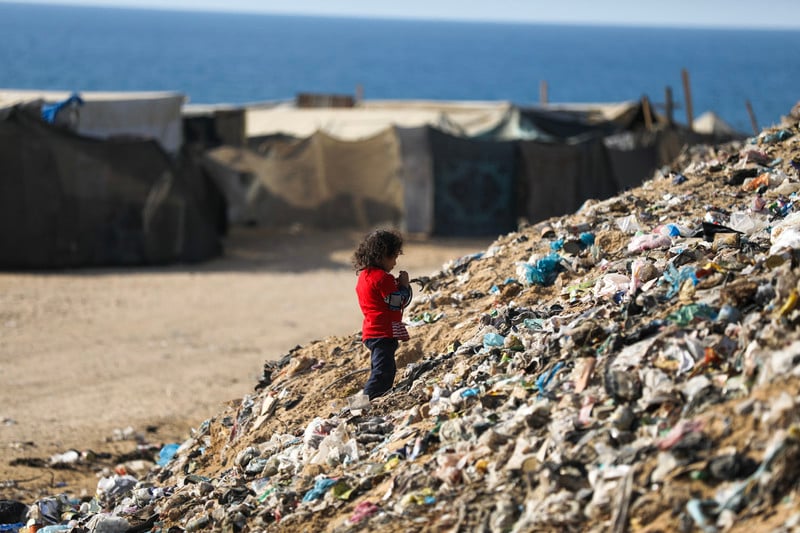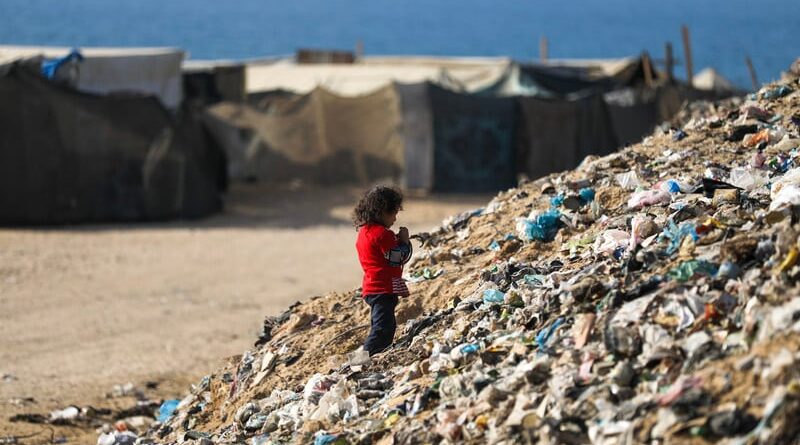The genocide in Gaza is a climate and environmental disaster

A Palestinian child collects garbage to sell in the Nuseirat refugee camp, in the middle of the Gaza Strip, on November 14.
ActiveStills
Israel’s offensive since October 2023 has made the densely populated Gaza Strip – just 25 kilometers long and six miles – unlivable.
Despite the strong environmental impact and the effects of global climate stability, the destruction of Gaza’s environment, environment and food production systems has not been addressed by international measures.
Ecocide has been defined by independent experts as “illegal or uncontrolled actions carried out with the knowledge that there is a high probability of serious and widespread or long-term damage to the environment caused by those actions .”
From the beginning, Israel was honest about its goal: the destruction of Gaza.
Israel’s indiscriminate attacks and the use of weapons of mass destruction are intended to cause as much damage as possible. This has not only led to great harm to the population but also to the destruction of the entire environment.
Israel has damaged or destroyed all five of Gaza’s water treatment plants, “contaminating coastal and coastal waters, soil and possibly groundwater,” according to the International Environmental Review. United published in June. Untreated sewage discharged into the Mediterranean Sea pollutes the marine environment and coastal areas. It could also harm Gaza’s fishing industry – fishing is the main source of food and fishing, a traditional occupation in the region, where food insecurity and unemployment rates are very high.
“Marine pollution can destroy nutrition and water quality, thereby inhibiting fish growth and thus affecting fish production and fishing,” according to the United Nations analysis.
“Pollution can also affect food security, as fish in the coastal areas (which are now the only places Palestinians can catch) can become contaminated,” the United Nations adds.
The wetlands of Wadi Gaza, an internationally important refuge for migratory birds and other wildlife where ecological restoration was ongoing until October 2023, have been damaged by military operations and pollution, which threaten their diversity. It is believed that 25 to 50 percent of Wadi Gaza has been destroyed since June, “along with the environmental services it provides,” says the United Nations.
In addition, fresh water sources such as wells and groundwater reservoirs are polluted, affecting people’s access to safe drinking water and damaging the vital ecosystems that depend on these sources.
Polluted waste, rotting bodies
Israel’s attacks have resulted in the accumulation of more than 42 million tons of garbage across Gaza, much of it contaminated with asbestos, unexploded ordnance and other toxic waste. Israel’s strict restrictions on fuel imports and lack of proper equipment have also hindered the recovery of thousands of corpses rotting under the rubble, exacerbating the humanitarian and humanitarian crisis. environment.
The collapse of solid waste management systems due to Israeli destruction has also led to the creation of approximately 225 waste disposal sites across Gaza, some hundreds of meters long, as was reported by the Dutch association PAX in July this year. UNRWA, the United Nations agency for Palestine refugees, reported in June that more than 330,000 tons of solid waste had accumulated in populated areas of Gaza – enough to fill more than 150 football fields. , according to PAX. These areas have become breeding grounds for pests, rodents and disease among displaced Gazans.
Satellite images reviewed by the BBC show that more than half of Gaza’s water and sanitation facilities have been damaged or destroyed. Most of the wastewater treatment and desalination plants have stopped working completely, leading to the flow of untreated sewage into the sea, streets and refugee camps. This poses a serious threat of groundwater contamination, which increases the risk of water-borne diseases, especially among vulnerable populations including children, women and people with disabilities. with chronic diseases.
The agriculture sector has also been heavily targeted.
As of March, nearly half of Gaza’s tree crops – including olive groves – had been destroyed, as had a third of Gaza’s vegetation, according to the report. Caretaker based on satellite images. Ninety percent of greenhouses in northern Gaza were “destroyed in the early stages of the ground attack,” according to UK research group Forensic Architecture.
A study by Samer Abdelnour and Nicholas Roy estimates that 80,000 tons of carbon are expected to be released during the process of clearing debris in Gaza. It would take about 3.3 million trees a year to absorb this amount of carbon dioxide, based on the absorption rate of one mature tree, which is about 22 kilograms of carbon dioxide (about .024 tons) each year.
This is on top of the carbon emissions from the continued flow of heavy weapons from the United States to Israel in the last year of ecocide. One study conservatively indicates that “the weather costs of the first 60 days of the Israeli military response were equivalent to burning at least 150,000 tons of coal,” Caretaker Reports – almost half of the carbon dioxide emissions produced by US goods go to Israel.
A 2022 study estimating global military output found that the military accounts for about 5.5 percent of carbon dioxide emissions each year.
“If the world’s soldiers were a country, they would have the fourth largest area in the world, much larger. [the] All of Russia,” the survey says. “Only China, the US and India would have larger carbon footprints.”
Carbon emissions associated with Israel’s aggression in Gaza contribute to climate change, extreme weather, sea level rise and harmful effects on the world’s environment and human health, including air pollution, respiratory diseases and food and water shortages.
Despite constant warnings about the climate emergency, there has been very little coverage of the dangerous and long-term environmental consequences of Israel’s continued assault on Gaza, or other wars around the world.
Israel has increased the budget for the Ministry of Environmental Protection to support projects aimed at reducing the environmental impact on it as it causes significant damage in Gaza and the wider region.
Words versus action
There is a huge gap between the global environmental discourse and the total failure to address the environmental problems of military conflicts and hold war criminals accountable.
We cannot say that progress is being made towards sustainability through annual conferences, climate movements and global peace efforts as long as blatant violations of environmental laws are taking place without and consequences.
Global initiatives dealing with humanitarian issues must ensure that the law applies to all without exception. This is the only way that organizations will take important environmental issues such as microplastics, water and soil pollution seriously, not to mention the devastating effect of war on the environment.
Israel’s military actions in Gaza may have violated several legally binding environmental agreements to which it is committed, including the Paris Agreement, the Convention on Biological Diversity and the Mediterranean Action Plan under a Barcelona Convention.
The use of heavy weapons and explosives in densely populated areas releases greenhouse gases and toxins, undermining emissions reduction targets under the Paris Agreement. The destruction of fields, wetlands and marine areas destroys biodiversity, contradicting the aim of the Convention on Biological Diversity to protect the environment.
The bombing of Gaza’s sewage treatment plants – resulting in untreated sewage flowing into the Mediterranean, polluting the marine environment – violates the Barcelona Convention’s commitment to protect the waters of the Mediterranean.
In addition, hazardous waste and waste, including asbestos and non-explosive materials, remain unregulated – contrary to the principles of the Basel Convention on safe disposal of waste.
The agreement, which Israel has signed, includes the release of the parties’ debts in the event of war. Although this provision addresses uncontrolled situations, it can also hinder accountability for the management of hazardous waste in conflict zones. Additional projects or reforms are needed to address the specific environmental problems resulting from armed conflict – as is clearly evident in Gaza.
Israel has proudly violated the principles of international humanitarian law, also known as the laws of war, with very few consequences. It has also criticized its legal environmental obligations in a clear manner, with serious consequences for the local and regional environment and global efforts to prevent climate change.
The ongoing genocide in Gaza exposes the colossal failure of international institutions and the illusion of rules-based governance. The chaos of ecocide that continues amid international silence has weakened the credibility of global environmental organizations, highlighting the persistent impossibility of enforcing international laws and stopping environmental damage.
If people can’t deal with these problems in little Gaza, what hope is there for the planet as a whole?
Islam Elhabil is a Malaysian-based microplastics specialist, PhD researcher and engineer specializing in engineering solutions for global environmental problems.
Tags
#genocide #Gaza #climate #environmental #disaster

